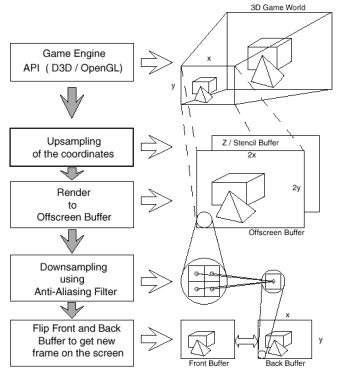Matrox Parhelia-512 - The Challenger
16x Fragment Anti-Aliasing
Anti-aliasing has become an established technology for improving the image quality in 3D games. It eliminates the jagged edges effect that occurs on 3D objects in a scene. What causes this annoying effect is low screen resolution. Even at 1280 x 1024, not enough pixels are available to display a slanted line smoothly on the monitor.
Anti-aliasing combats this effect by decreasing the intensity of neighboring pixels in the line. However, this also causes the line to become less clear. By increasing the resolution of the monitor, this effect is in turn lessened. In practice, a smoother edge significantly increases the subjective perception of resolution.
In action scenes, the jagged edges lead to an annoying flickering effect, since the 3D perspective (and therefore the angle between the edge of the object and the observer) continually changes. Anti-aliasing also mitigates this effect.
Currently, Multisample Full Scene Anti-aliasing (FSAA) is the established technology - it has been used by NVIDIA since the GeForce 3 and significantly optimized in the GeForce 4. Supersampling belongs to the previous generation and is used by Radeon and GeForce 2, for example. To put it simply, an image is rendered in double or quadruple resolution, then filtered and resampled to the final resolution. On the monitor, the color of a pixel is set to the middle value from four of the original pixels (with 2x FSAA, this results in double the image size). This allows the hard edges to be smoothed out, as described above.
The disadvantage of this technique is that it generates a huge amount of data within a very short period of time, all of which needs to be processed. Here, the restriction in bandwidth strongly limits the performance. Multisampling is an optimized version of supersampling, in which the efficiency of several processes is increased. With supersampling, four textures are needed to determine the final color value of a pixel (based on four original pixels). By comparison, multisampling requires only one texture, which is then used four times in sequence. This makes multisampling significantly more effective and faster. With the GeForce 4, NVIDIA came up with further optimizations to boost performance. The loss in speed with 2xFSAA for a GeForce 4 Ti card is extremely small. NVIDIA even provides the inexpensive MX version with an extra hardware unit for FSAA.
Get Tom's Hardware's best news and in-depth reviews, straight to your inbox.
Current page: 16x Fragment Anti-Aliasing
Prev Page 36-Stage Shader Array, Including 64 Super Sample Texture Filtering Next Page 16x Fragment Anti-Aliasing, Continued
